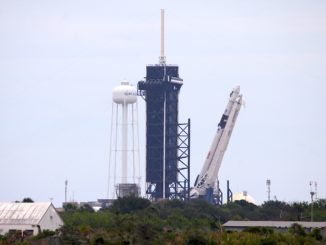
A piece of America’s space history is now on the ocean’s floor. During its return voyage to Port Canaveral in Central Florida, a SpaceX Falcon 9 first stage booster toppled over and broke in half.
This particular booster, tail number B1058, was coming back from its record-breaking 19th mission when it had its fatal fall. The rocket lifted off from Cape Canaveral Space Force Station on Dec. 23 carrying 23 Starlink satellites. The booster made a successful landing eight and a half minutes after launch on the drone ship ‘Just Read the Instructions’ which was stationed east of the Bahamas. SpaceX said in a statement on social media that it succumbed to “high winds and waves.”
The company stated that “Newer Falcon boosters have upgraded landing legs with the capability to self-level and mitigate this type of issue.
In a separate post, Kiko Deontchev, the Vice President of Launch for SpaceX, elaborated by added that while they “mostly outfitted” the rest of the operational Falcon booster fleet, B1058 was left as it was, “given its age.” The rocket “met its fate when it hit intense wind and waves resulting in failure of a partially secured [octo-grabber] less than 100 miles from home.”

“We came up with self-leveling legs that immediately equalize leg loads on landing after experiencing a severe tippy booster two years ago on Christmas,” Deontchev wrote, referring to the first flight of the B1069 booster.
“One thing is for sure, we will make lemonade out of lemons and learn as much as possible from historic 1058 on our path to aircraft-like operations,” he added.
An American tail(number)
Beyond its status as the flight leader in SpaceX’s Falcon fleet with 19 completed missions, B1058 also held the distinction of launching astronauts from American soil for the first time since the end of the Space Shuttle program in 2011.
Former NASA astronauts Bob Behnken and Doug Hurley were the first to climb aboard a SpaceX Crew Dragon spacecraft to fly to the International Space Station on May 30, 2020. That historic mission, dubbed Demo-2, began the illustrious mission career of B1058 that spanned more than three years.
To mark its landmark flight, the booster was emblazoned with both the official NASA logos, nicknamed the “meatball” and the “worm.” This became the first crewed flight in NASA’s Commercial Crew Program, which began a new chapter of the agency purchasing commercial services to shepherd astronauts to and from the orbiting outpost.
When the booster was being prepared for the Demo-2 mission, NASA and SpaceX determined the loss-of-crew (LOC) probability to be 1-in-276, beating the program-required threshold of 1-in-270.
Crew Dragon Endeavor docked with the ISS 19 hours after launching from NASA’s Kennedy Space Center in Florida.
While the Demo-2 flight was the only crewed mission using B1058, the booster did support one additional mission to the Space Station when it launched a Cargo Dragon spacecraft, designated C208, on SpaceX’s 21st Commercial Resupply Services (CRS-21) mission on Dec. 6, 2020.
The other 17 flights of this booster included the first and third of SpaceX’s Transporter missions, carrying an array of CubeSats and NanoSats to orbit, as well as 14 missions to send up satellites for SpaceX’s Starlink internet constellation.
Gone, but not forgotten
On Tuesday, Dec. 26, the remaining portion of B1058 was brought into Port Canaveral onboard ‘Just Read the Instructions.’ A collection of photographers, reporters and on-lookers gathered along the entryway to the port to catch a glimpse of what was left of the booster.
Most of the engine section of the rocket appeared to be in tact, judging from photos and three of the four landing legs jutted into the air, propped open as they were following the booster’s landing.

Looking from the top of the booster remnants, wires were drawn out and strewn over the edge of the droneship, dragging in the water as the vessel made it back to its dock.
While B1058 will never fly again, SpaceX fully intends to preserve what’s left and understand what they can.
“We are planning to salvage the engines and do life leader inspections on the remaining hardware,” said Jon Edwards, the Vice President of Launch Vehicles and Falcon 9 Product Director at SpaceX. “There is still quite a bit of value in this booster. We will not let it go to waste.”



